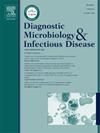HIV/AIDS患者肠道原虫和微孢子虫的分子检测
IF 1.8
4区 医学
Q3 INFECTIOUS DISEASES
Diagnostic microbiology and infectious disease
Pub Date : 2025-08-14
DOI:10.1016/j.diagmicrobio.2025.117068
引用次数: 0
摘要
本研究采用分子方法研究人类免疫缺陷病毒(HIV)感染患者的机会致病菌隐孢子虫、肠贾第鞭毛虫、囊虫和微孢子虫,并确定相关危险因素。方法随机抽取100例hiv血清阳性患者,50例健康人作为对照组。报告在研究期间接受抗寄生虫治疗的参与者被排除在外。囊虫和微孢子虫采用常规聚合酶链式反应(PCR)检测,隐孢子虫和肠芽孢杆菌采用巢式PCR检测。结果22%的HIV/ AIDS患者检出囊虫,17%的患者检出微孢子虫,12%的患者检出隐孢子虫,11%的患者检出肠芽胞虫。对照组中,囊虫检出率为8%,微孢子虫检出率为6%,隐孢子虫检出率为2%,未检出肠芽孢杆菌。患者与对照组间肠隐孢子虫(p = 0.001)、隐孢子虫(p = 0.009)、微孢子虫(p = 0.013)、囊虫(p = 0.029)患病率差异均有统计学意义。12%的HIV/AIDS患者存在多重寄生虫感染,而对照组未发现多重寄生虫感染病例。结论hiv /AIDS患者感染肠隐孢子虫、隐孢子虫、微孢子虫和囊虫的风险较高。鉴于多种寄生虫的存在,HIV/AIDS患者的粪便样本应采用针对所有主要肠道寄生虫的综合诊断方法进行常规筛查。本文章由计算机程序翻译,如有差异,请以英文原文为准。
Molecular detection of intestinal protozoa and microsporidia in HIV/AIDS patients
Introduction
This study investigate opportunistic pathogens Cryptosporidium spp, Giardia intestinalis, Blastocystis, and microsporidia species in patients with human immunodeficiency virus (HIV) infection using molecular methods, and to identify associated risk factors.
Methods
The study included 100 randomly selected HIV-seropositive patients, along with 50 healthy individuals as the control group. Participants who reported receiving antiparasitic treatment during the study period were excluded. Conventional polymerase chain reaction (PCR) was used to detect Blastocystis and microsporidia, while nested PCR was employed to identify Cryptosporidium spp. and G. intestinalis.
Results
Blastocystis was found in 22% of the of HIV/acquired immunodeficiency syndrome (AIDS) patients, as was microsporidia in 17%, Cryptosporidium spp. in 12%, and G. intestinalis in 11%. In the control group, Blastocystis was detected in 8%, microsporidia in 6% and Cryptosporidium spp. in 2%, while G. intestinalis was not detected. The differences in the prevalence of G. intestinalis (p = 0.001), Cryptosporidium spp. (p = 0.009), microsporidia (p = 0.013), and Blastocystis (p = 0.029) between the patient and control groups were statistically significant. Multiple parasitic infections were identified in 12% of HIV/AIDS patients, whereas no cases of multiple parasitism were observed in the control group.
Conclusion
HIV/AIDS patients were found to be at increased risk for G. intestinalis, Cryptosporidium spp., microsporidia, and Blastocystis. Given the presence of multiple parasitism, stool samples from HIV/AIDS patients should be routinely screened using comprehensive diagnostic methods targeting all major intestinal parasites.
求助全文
通过发布文献求助,成功后即可免费获取论文全文。
去求助
来源期刊
CiteScore
5.30
自引率
3.40%
发文量
149
审稿时长
56 days
期刊介绍:
Diagnostic Microbiology and Infectious Disease keeps you informed of the latest developments in clinical microbiology and the diagnosis and treatment of infectious diseases. Packed with rigorously peer-reviewed articles and studies in bacteriology, immunology, immunoserology, infectious diseases, mycology, parasitology, and virology, the journal examines new procedures, unusual cases, controversial issues, and important new literature. Diagnostic Microbiology and Infectious Disease distinguished independent editorial board, consisting of experts from many medical specialties, ensures you extensive and authoritative coverage.

 求助内容:
求助内容: 应助结果提醒方式:
应助结果提醒方式:


